Looks like this year will be the year of ‘the breads’ as I am getting better at baking simple breads at home – much to my husband’s delight. I am so glad that I am part of this baking group called ‘We Knead to Bake’ where Aparna chose this lovely Pane Siciliano, a sesame topped semolina bread from Sicily. On the 13th of December every year, feasts are held in Sicily and around the world celebrating the bravery of Santa Lucia. During this feast a special bread known as the Pane Siciliano (Bread of Sicily) is baked using a specific grind of durum wheat called ‘semola di grano duro rimacinato’ or just ‘rimacinato’, which means ‘ground again’. This refers to semolina which is ground once more to break the coarser grain into finer flour for bread. If ‘rimancinato’ is available where you live, then you can use that otherwise look for the finest semolina that we call as sooji rawa in India (used to make laddoos and sheera) and run it through the dry grinding jar of your mixer-grinder to achieve a fine flour. Sounds easy?
The quality and freshness (in terms of packaging) of yeast plays a big role in preparing any kind of bread and so it was the case here. When I first embarked upon the journey of making this bread my yeast didn’t froth. After discarding two batches I went ahead and decided to make the dough anyways. Big mistake. As expected, the dough didn’t rise much and didn’t turn out as it should have. What a waste of time and ingredients I thought to myself, but not much of a waste of effort as every experiment teaches us something new. I realised that I was lazy to grind the semolina to a fine flour and also didn’t bother about the yeast and its quality. The resultant bread was like a dead rock – very hard on the outside and hence extremely hard to cut but the taste of the crumb was so wonderful that I was compelled to correct my mistakes and give it a shot again. I just decided to go and buy the semolina flour so that it left no scope for more mistakes. After a big hunt in all the supermarkets that I could go to and not having found the flour of my dreams I decided to make the bread from scratch -grind the semolina to a finer texture this time and make sure that the yeast behaved.
Having been there, done that, the second attempt was much easier and happened much faster than I thought. This time around I decided to shape it into a ‘Mafalda’ meaning ‘Snake’ (the Pane Siciliano is generally shaped into a Mafalda or the Occhi di Santa Lucia meaning ‘the Eyes of St. Lucia). The first time around the idea of eating a bread shaped like a snake put me off but honestly, the shape doesn’t really matter. If you scroll down to the very bottom of this post you can see the ‘Occhi’ shaped bread from my first attempt (the dead rock!)
The coiled up ‘snake’ was pretty easy to shape – just roll the dough into a ‘rope’ and then shape it into an ‘S’ and place one end of the rope, rolled slightly thinner right over the ‘S’. Simple!
The best part of this bread is that the pre-ferment or the ‘cresciuta’ gives the crumb so much flavour that you can keep munching on this bread all day long. Although I don’t really munch on bread like I have no other work I did just that since the day I made the ‘Occhi’. I ate the rather hard bread that day with butter and Nutella and the saga continues with the ‘Mafalda’ as well! I just can’t seem to get over this bread especially because it tastes so good! I urge you to try this bread and I hope you enjoy it as well! Buon Appetito!
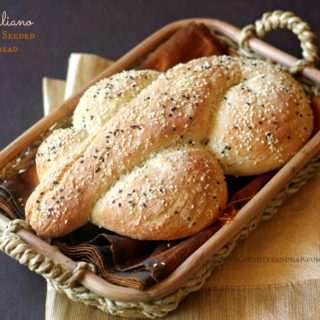
Pane Siciliano (Sicilian Sesame Seeded Semolina Bread)
This artisan bread from Italy is made with semolina and topped with sesame seeds and shaped into a 'mafalda' (snake shape).
Print
Pin
Rate
Ingredients
For the Cresciuta (Biga/ Pate Fermentee):
- 1/4 cup lukewarm water * see notes
- 1/4 tsp active dry yeast I used instant yeast * see notes
- 1/4 cup all-purpose flour maida
For the Dough:
- 1/2 tsp active dry yeast I used instant yeast
- 1 cup lukewarm water 110° to 115°F
- 2 tsp honey
- the prepared Cresciuta
- 2 to 2 1/2 cups fine semolina or durum semolina flour * see notes
- 1/2 tsp vital wheat gluten optional
- 1 tsp salt
- 1 tbsp olive oil
- A little water for brushing on the bread
- 1/8 cup sesame seeds white or black
Instructions
- First make the Cresciuta. Dissolve the yeast in the warm water in a small bowl and let it froth, it could take about 10 mins. Once frothy, stir in the flour with a fork and loosely cover the bowl. This mixture should be a little pasty/stringy. Leave it in a slightly warm place for at least 4 hours, preferably overnight.
- The next morning, mix the dough for the bread. In a large bowl dissolve the yeast in the warm water mixed with the honey. Let it stand for 10 minutes till it is frothy. Once frothy add the cresciuta and mix well. Reserve 1/2 cup and add 2 cups of the semolina flour, the gluten (if using), salt and olive oil and mix it well to form a dough. Dust the remaining 1/2 cup of the flour in parts until the dough is less sticky – it will be a little soft.
- Place the dough in a lightly oiled bowl, turn it to coat well, then loosely cover and let the dough rise till it doubles in volume for about 1-1/2 hours.
- Gently deflate the dough with your fingers and then roll it out into a ‘rope’ that is about 30” long. Place the rope of dough on a baking sheet lined with lightly greased baking parchment and curl the dough back and forth (S shape) leaving itself a 6 or 7 inch tail. Roll the tail a little thinner than the rest of the body so that it looks like it’s tapering off. Fold the tail over the shaped loaf.
- Loosely cover and let the shaped dough rise for 2 hours till almost double in size.
- Once the dough has doubled lightly brush the top with water and then sprinkle the sesame seeds and press them in lightly with your fingers.
- Pre-heat your oven to 190 C (375F) with a baking tray placed upside down in it. Place the baking tray with the dough on the hot tray and bake for about 30 minutes until the bread is brown and done, and sounds hollow when tapped on the bottom. Remove and completely on a wire rack before slicing.
Notes
1. Always use good quality and new (check packaging date and expiry) yeast. If the yeast is old, it will not froth as it should and there is no point baking your bread with it. It is better to discard and start again. If however despite this your yeast does not froth or you are living in cold weather/central AC try placing the bowl of the yeast mixture in a larger bowl of hot water. I noticed that it will help the lukewarm water in which the yeast has been dissolved to maintain its temperature and aid the frothing. You can also add 1/2 teaspoon honey to the mixture when you make the Cresiuta as it will aid the frothing.
2. I always like to use instant yeast which is similar to active dried yeast but has finer granules and need not be dissolved in water, yet I did that for better results.
3. Since I didn’t find readymade semolina flour I bought the finest semolina I could find (sooji rawa) and ground it to a fine texture in the dry grinding jar of my mixie. If you are following this method make sure not to overload your mixie jar – fill it upto half its capacity and grind the semolina for best results. 2 cups of sooji rawa will yield you approx 2-1/4 cups of semolina flour as the volume increases once ground. You will need just about this amount, but if you feel that the dough is still sticky/gooey (sticks like paste to your hand) then grind some extra semolina and dust the flour. The dough is supposed to be soft and slightly sticky (but not paste like)
2. I always like to use instant yeast which is similar to active dried yeast but has finer granules and need not be dissolved in water, yet I did that for better results.
3. Since I didn’t find readymade semolina flour I bought the finest semolina I could find (sooji rawa) and ground it to a fine texture in the dry grinding jar of my mixie. If you are following this method make sure not to overload your mixie jar – fill it upto half its capacity and grind the semolina for best results. 2 cups of sooji rawa will yield you approx 2-1/4 cups of semolina flour as the volume increases once ground. You will need just about this amount, but if you feel that the dough is still sticky/gooey (sticks like paste to your hand) then grind some extra semolina and dust the flour. The dough is supposed to be soft and slightly sticky (but not paste like)
Disclaimer
The nutritional values are only indicative.
Tried this recipe?Please leave a comment & rate the recipe below or share a photo on Instagram and tag me @ruchikrandhap
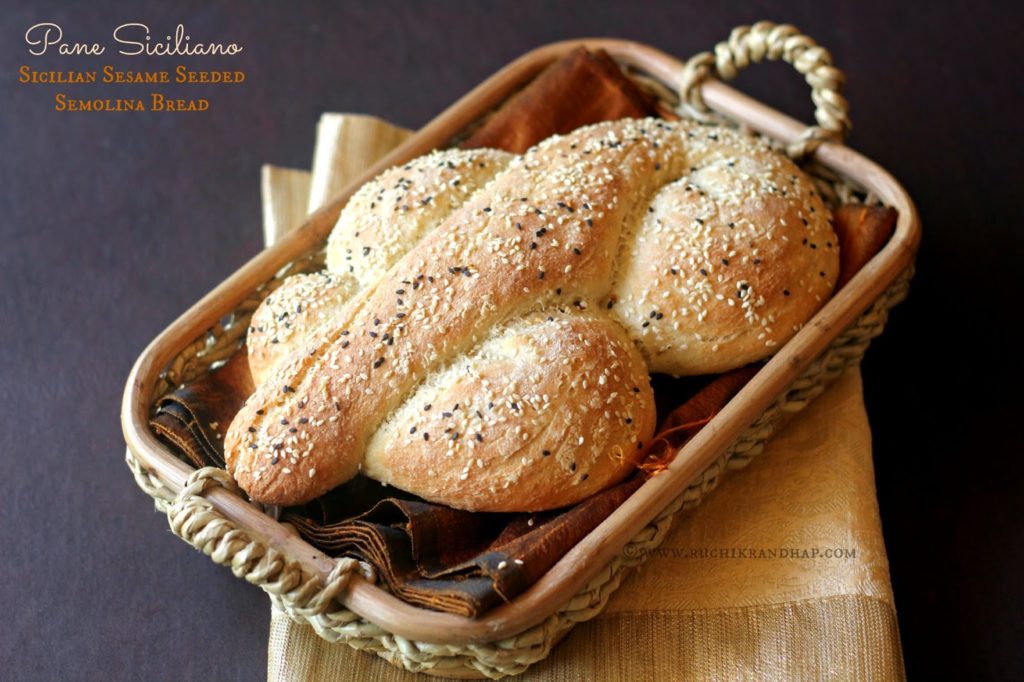
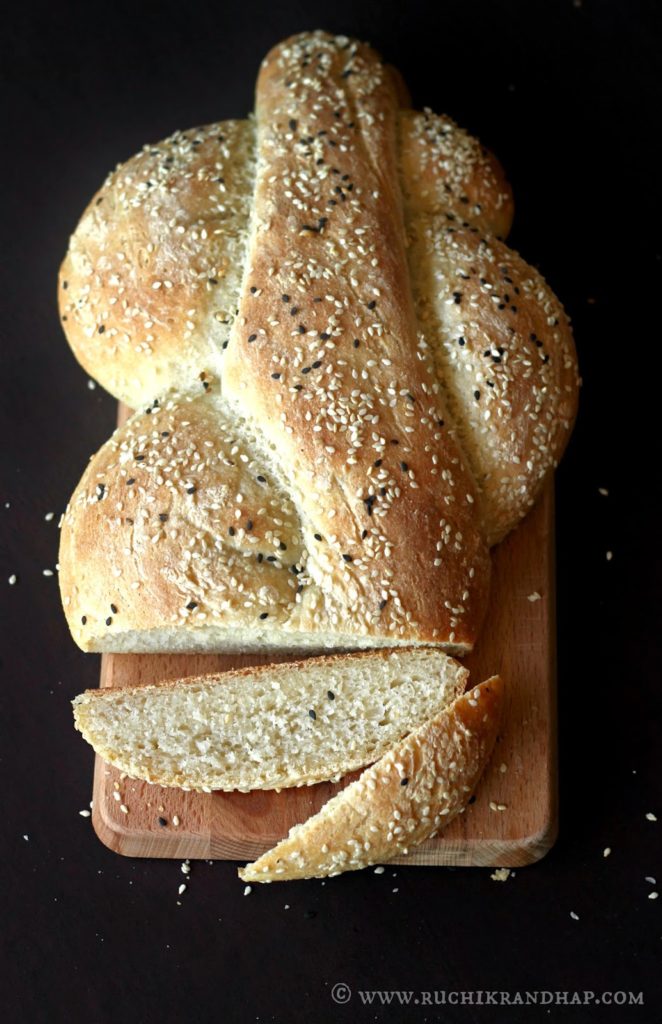
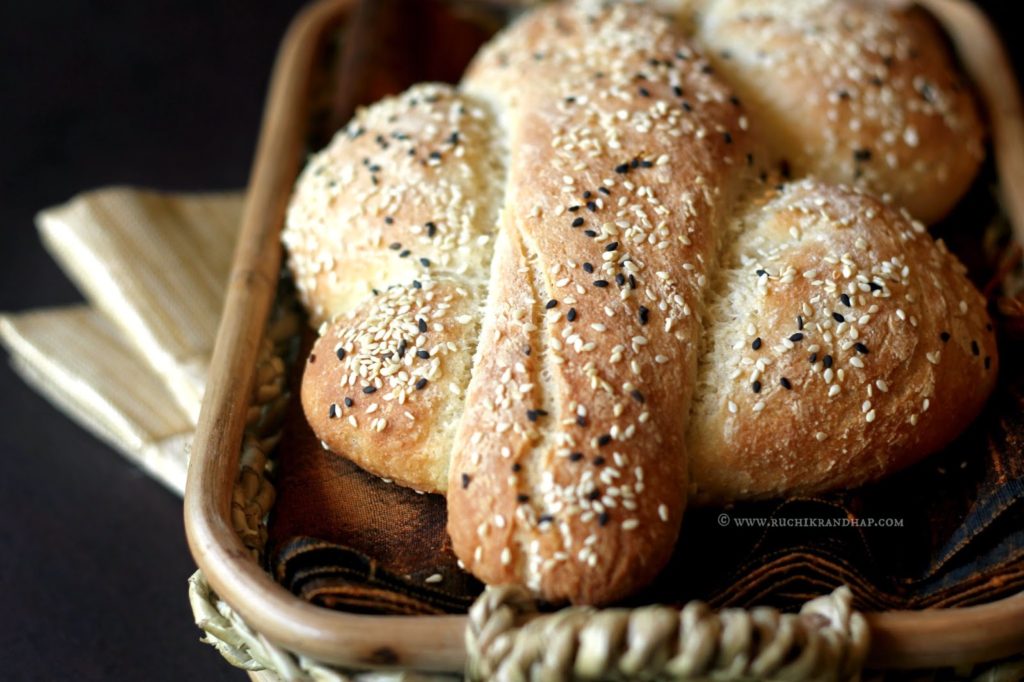
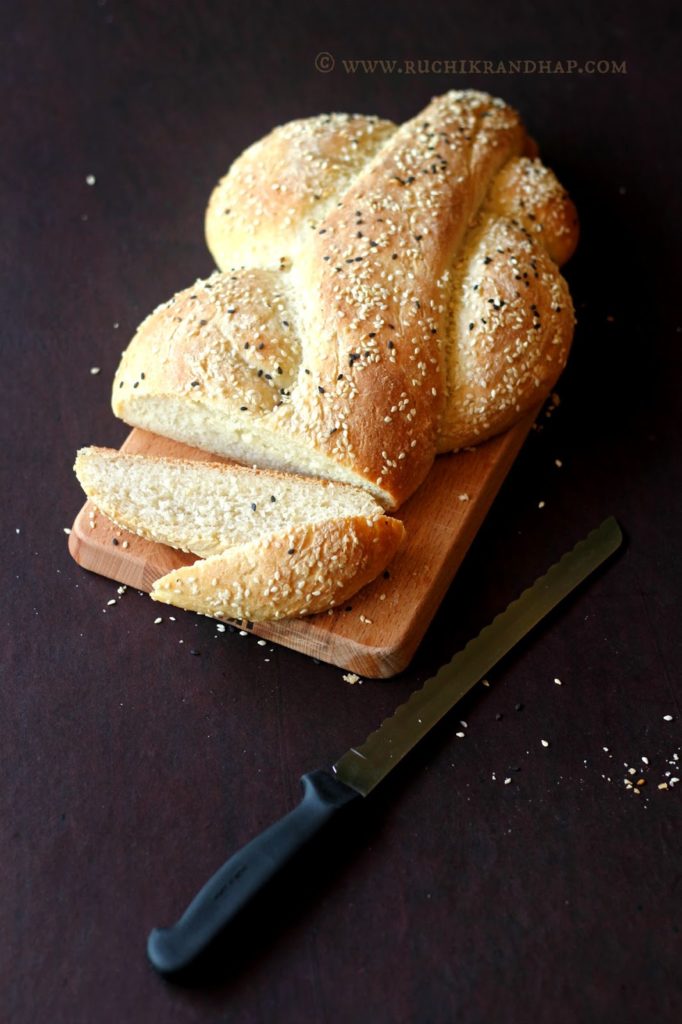
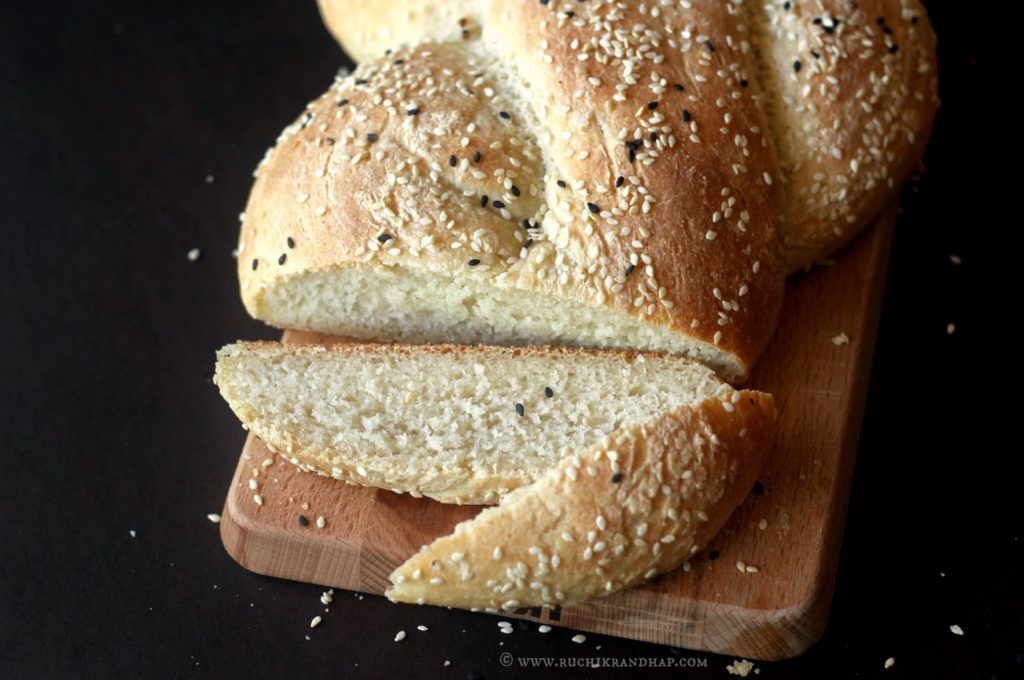
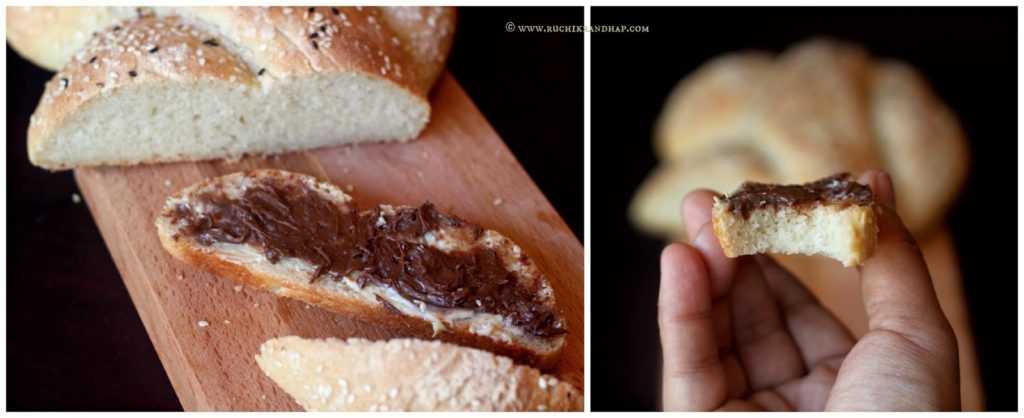
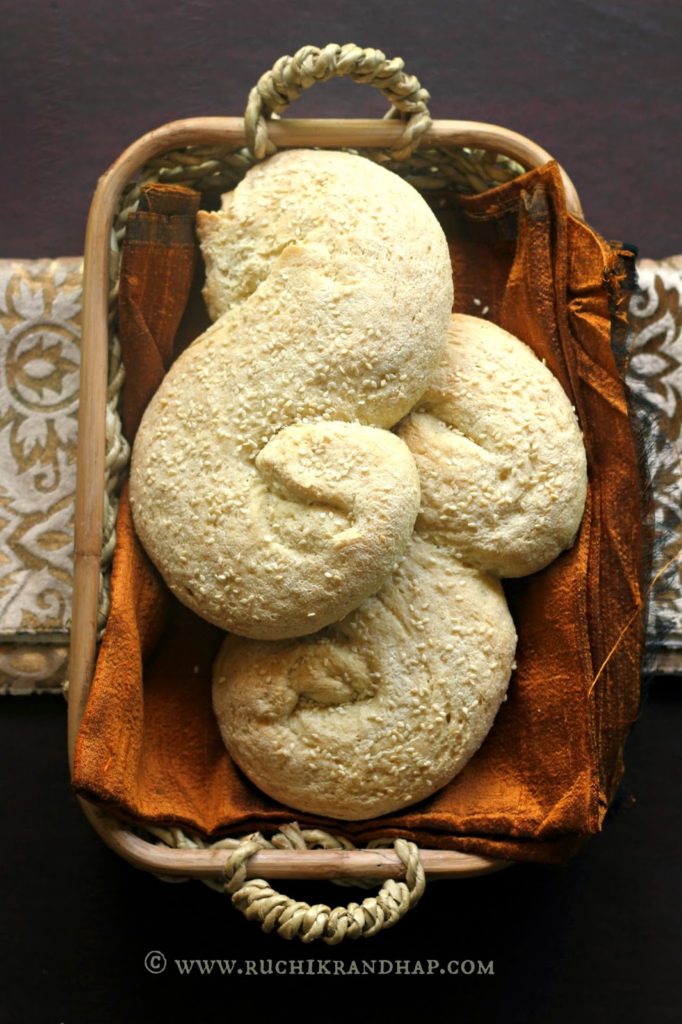
Shireen your semolina bread looks awesome!. Its in my to do list. I love baking wheat breads and love taking a bite of freshly baked warm breads. Thanks so much!
I too agree about your breadmaking skills and waiting for you to post many more such bread based recipes.
Deepa
@ Mithu: Thanks so much!! I hope you give this a try and like it too!!
@ Deepa: Why don't u join the group? I am sure you will enjoy making different kinds of bread with all of us 🙂